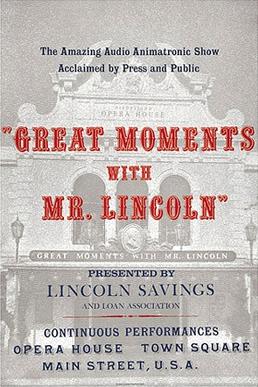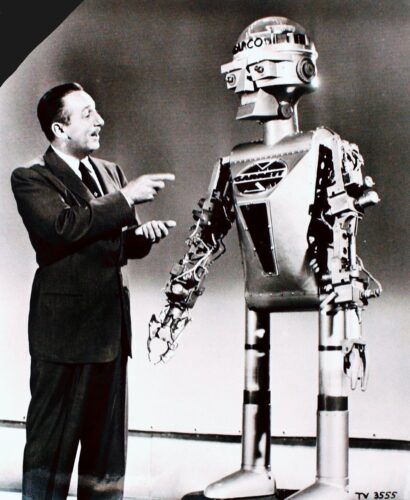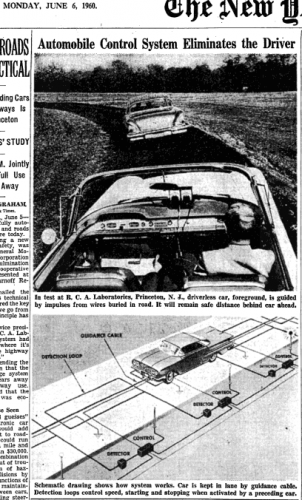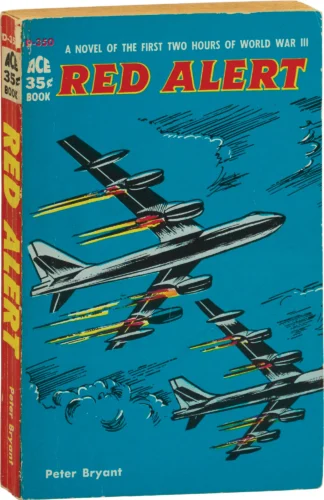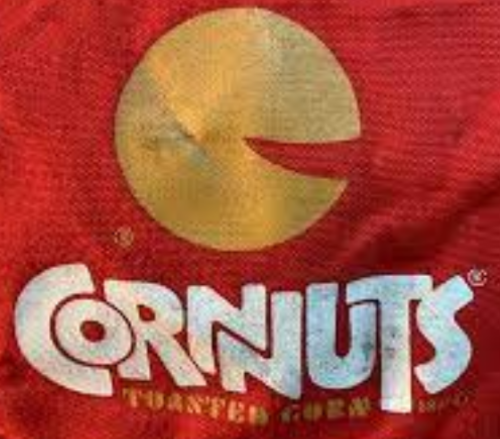
Corn Nuts, a well-known brand, essentially offer fried and salted corn. While this snack isn’t particularly novel, as variations exist worldwide, its marketing suggests a significant influence on American culture. It’s almost a given that any rural gas station will stock bad coffee and Corn Nuts, highlighting widespread popularity of the snack. However, what’s intriguing is how a single American brand came to dominate such a simple and common food without any real explanation.
But I’m getting ahead of myself.
Initially, the brand originated in Oakland, California, where a man named Olin Huntington invoked the well-known “Brown Jug” drinking song that had surfaced in 1869, shortly after the Civil War.
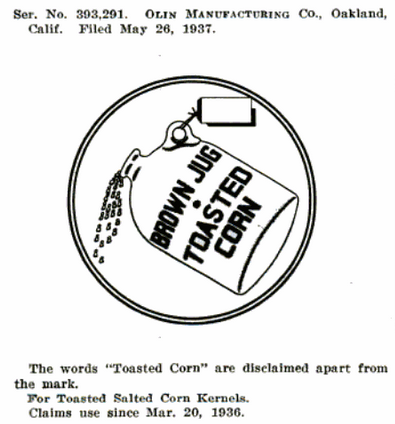
My wife and I lived all alone,
In a little log hut we called our own;
She loved gin and I loved rum,
I tell you we had lots of fun.Chorus: Ha! Ha! Ha! you and me,
Little Brown Jug don’t I love thee!‘Tis you who makes my friends and foes,
‘Tis you who makes me wear old clothes,
Here you are so near my nose,
So tip her up and down she goes.When I go toiling to my farm
I take little brown jug under my arm,
Place him under a shady tree,
Little brown jug, ’tis you and me.If I’d a cow that gave such milk,
I’d clothe her in the finest silk
I’d feed her on the choicest hay,
And milk her forty times a day.The rose is red, my nose is too
The violet’s blue and so are you;
And yet I guess, before I stop
I’d better take another drop.Went for a walk on the railroad track,
Little brown jug on my back.
Stubbed my toe, and down I fell,
And broke that little jug I loved so well.
Isn’t it catchy? It’s worth noting how famous the Brown Jug still was by the 1930s, when Olin’s particular version of salted fried corn started appearing for free in Oakland bars.
Moreover, again considering the Civil War influence on American culture, Olin’s recipe perhaps resembled a snack known very well by soldiers, as described by Serious Eats:
…regular dry corn, which tended to be stolen from local fields and was used to make [pinole] (parched corn ground to a fine powder, seasoned with salt or sugar and eaten dry)
It seems at the very least that Confederate soldiers were familiar with a food preservation technique that meant roasting or parching stolen corn kernels. This method likely provided pro-slavery militants with a comfort food during long and desperate retreats renowned for drunken looting and pillaging.
How and why did toasted corn also migrate West? Some could argue Americans on the California Trail through the late 1800s needed a convenient, light and durable food option that could withstand rigors of travel and provide much-needed energy. Others rightly might argue those are the exact same reasons that pinole had long been a common staple of native Americans and other long hunters. In other words, was any food in the 1930s (after prohibition) more comforting than a drink with some familiar corn on the side?
Voila!
While Olin’s Brown Jug Toasted Corn might sound like an odd brand to someone today, in 1936 that combination of words probably sounded more like someone saying water is wet. It was brilliant marketing for his day.
Thus the Oakland bars serving toasted corn rapidly grew the snack’s popularity until they ran directly into fierce political headwinds. A huge influx of hungry immigrants to California generated intense resentment towards “Okies” seeking a better life during the Dust Bowl. Free food? Suddenly a Brown Jug Toasted Corn model of handing out bar snacks was basically regulated out of business.
A man named Olin Huntington created a toasted corn product called Brown Jug and sold it to bars, which handed it out to patrons for free. The toasted corn was legendarily so popular, especially with children, that kids were often caught dashing into taverns to grab handfuls.
But shortly thereafter, California passed a law making it illegal to give away food at bars, spelling disaster for Brown Jug’s business model.
An ages old concept of using corn to feed starving Americans on long journeys became very popular with starving kids during the Dust Bowl? You don’t say.
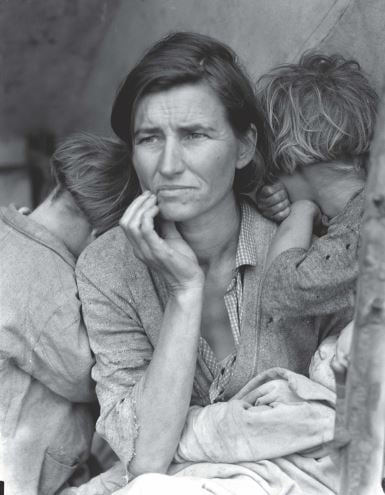
The new laws were apparently too much for Olin, so he threw in the towel and sold his company. The transfer of Olin Manufacturing and their Brown Jug Toasted Corn business to a new entrepreneur (Albert Holloway) included a huge marketing reversal. Not only did the product now distance itself from an association to drinking, it added a 5 cent charge. The new focus shifted to selling small bags into schools as wholesome snacks for children… if they could pay ($1.50 in today’s terms).
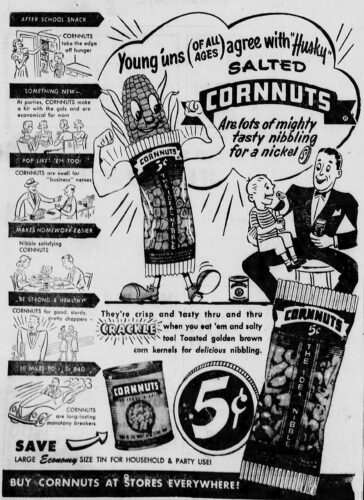
The product was renamed based on what bar patrons, and possibly children, reportedly called out when they didn’t want salted peanuts: “hey bartender, how about some more of those corn nuts”.
Lastly, after all that history being said, the appeal of Corn Nuts lies in what reporters called a “pure and simple” concept. Something that seems very well-known around the world – oily corn with salt is delicious, and sustaining on long journeys. No wonder it’s in every gas station.
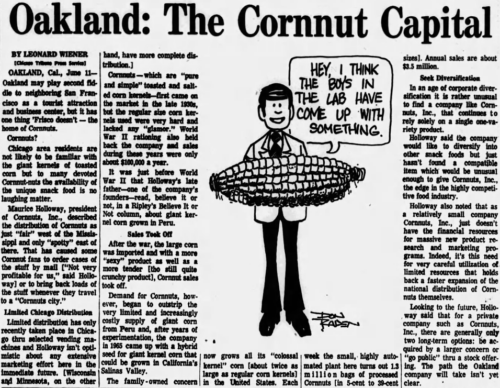
The perplexing part of the story is how a single brand with a single product came to dominate the American market to such an extent, given such obvious potential for numerous producers of salted fried corn to emerge.
However, dominance might be linked to the obscure politics of its origin story. It benefited from a hard turn away from the common snack associated with drinking and starving, into a conveniently packaged snack for kids… if they could pay.
By distancing from America’s controversial yet widely recognized Civil War, Brown Jug and Dust Bowl history (let’s face it, who today knows those lyrics), Corn Nuts successfully fabricated a strangely abrupt “pure and simple” origin story to build a dominant position in the convenience snack market.
Interestingly, this mirrors an abrupt and controversial racist origin to Doritos corn chips.
It begs a question of how and where the mostly forgotten Olin Huntington came upon his recipe that was then purchased and repurposed into a Corn Nuts empire. So far, I’ve found no evidence of Olin’s major influences, perhaps by design. It’s almost impossible to find any mention of Olin himself.
Related:
- Cancha is the word used in Peru and Ecuador for corn that has been soaked and then toasted in a pan with oil and salt. There tend to be different sizes, textures and regional variations.
- Cancha Chulpi is harvested young and tender, then toasted with seasoning and salt until it pops, emphasizing crunch.
- Cancha Pescorunto is a smaller corn often toasted with seasoning and salt until it pops, again emphasizing crunch.
- Cancha Serrana, or Andean corn, is found in Ecuador, Peru, Bolivia, and Colombia. Very large kernels are known for more of a starchy texture, frequently found in soups, stews, and side dishes. Like Cancha Chulpi and Pescorunto it can be toasted with salt.

